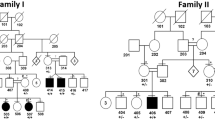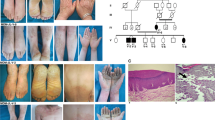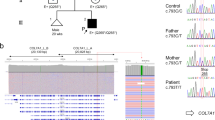Abstract
We have isolated the gene for human type I keratin 9 (KRT9) and localised it to chromosome 17q21. Patients with epidermolytic palmoplantar keratoderma (EPPK), an autosomal dominant skin disease, were investigated. Three KRT9 mutations, N160K, R162Q, and R162W, were identified. All the mutations are in the highly conserved coil 1A of the rod domain, thought to be important for heterodimerisation. R162W was detected in five unrelated families and affects the corresponding residue in the keratin 14 and keratin 10 genes that is also altered in cases of epidermolysis bullosa simplex and generalised epidermolytic hyperkeratosis, respectively. These findings provide further evidence that mutations in keratin genes may cause epidermolysis and hyperkeratosis and that hyperkeratosis of palms and soles may be caused by different mutations in the KRT9 gene.
This is a preview of subscription content, access via your institution
Access options
Subscribe to this journal
Receive 12 print issues and online access
$209.00 per year
only $17.42 per issue
Buy this article
- Purchase on Springer Link
- Instant access to full article PDF
Prices may be subject to local taxes which are calculated during checkout
Similar content being viewed by others
References
McKusick, V.A. Mendelian inheritance in man. 10 edn (Johns Hopkins University Press, Baltimore, 1992).
Vörner, H. Zur Kenntnis des Keratoma hereditarium palmare et plantare. Arch. Dermatol. Syph. (Berlin) 56, 3–31 (1901).
Thost, A. Ueber erbliche Ichthyosis palmaris et plantaris cornea. (Diss., Heidelberg, 1880).
Unna, P.G. Ueber das Keratoma palmare et plantare hereditarium. Arch. Dermatol. Syph. (Berlin) 15, 231–270 (1883).
Küster, W. & Becker, A. Indication for the identity of palmoplantar keratoderma type Unna-Thost with type Vörner. Thost's family revisited 110 years later. Acta Derm. Venereol. (Stockh.) 72, 120–122 (1992).
Reis, A., Küster, W., Eckardt, R. & Sperling, K. Mapping of a gene for epidermolytic palmoplantar keratoderma to the region of the acidic keratin gene cluster at 17q12–q21. Hum. Genet. 90, 113–116 (1992).
Lessin, S.R., Huebner, K., Isobe, M., Croce, C.M. & Steinert, P.M. Chromosomal mapping of human keratin genes: Evidence for non-linkage. J. invest. Dermatol. 91, 572–578 (1988).
Romano, V. et al. Chromosomal assignment of cytokeratin genes. Cytogenet. Cell Genet. 46, 683 (1988).
Rosenberg, M., RayChaudhury, A., Shows, T.B., LeBeau, M.M. & Fuchs, E. A group of type I keratin genes on human chromosome 17: Characterization and expression. Molec. Cell. Biol. 8, 722–736 (1988).
Knapp, A.C. et al. Cytokeratin no.9, an epidermal type I keratin characteristic of a special program of keratinocyte differentiation displaying body site specificity. J. Cell Biol. 103, 657–667 (1986).
Moll, I., Held, H., Franke, W.W. & Moll, R. Distribution of a special subset of keratinocytes characterised by the expression of cytokeratin 9 in adult and fetal human epidermis of various body sites. Differentiation 33, 254–265 (1987).
Steinert, P.M. Structure, function, and dynamics of keratin intermediate filaments. J. invest. Dermatol. 100, 729–734 (1993).
Moll, R., Franke, W.W., Schiller, D.L., Geiger, B. & Krepler, R. The catalog of human cytokeratins: patterns of expression in normal epithelia, tumors and cultured cells. Cell 31, 11–24 (1982).
Bonifas, J.M., Rothman, A.L. & Epstein, E.H. Epidermolysis bullosa simplex: Evidence in two families for keratin gene abnormalities. Science 254, 1202–1205 (1991).
Coulombe, P.A. et al. Point mutations in human keratin 14 genes of epidermolysis bullosa simplex patients: Genetic and functional analyses. Cell 66, 1301–1311 (1991).
Lane, E.B. et al. A mutation in the conserved helix termination peptide of keratin 5 in hereditary skin blistering. Nature 356, 244–246 (1992).
Dong, W., Ryynänen, M. & Uitto, J. Identification of a leucine-to-proline mutation in the keratin 5 gene in a family with the generalized Köbner type of epidermolysis bullosa simplex. Hum. Mut. 2, 94–102 (1993).
Compton, J.G. et al. Linkage of epidermolytic hyperkeratosis to the type II keratin gene cluster on chromosome 12q. Nature Genet. 1, 301–305 (1992).
Cheng, J. et al. The genetic basis of epidermolytic hyperkeratosis: A disorder of differentiation-specific epidermal keratin genes. Cell 70, 811–819 (1992).
Chipev, C.C. et al. A leucine-proline mutation in the H1 subdomain of keratin 1 causes epidermolytic hyperkeratosis. Cell 70, 821–828 (1992).
Rothnagel, J.A. et al. Mutations in the rod domain of keratins 1 and 10 in epidermolytic hyperkeratosis. Science 257, 1128–1130 (1992).
Lamgbein, L., Heid, H.W., Moll, I. & Franke, W. W. Molecular characterization of the body site-specific human epidermal cytokeratin 9: cDNA cloning, amlno acid sequence, and tissue specifity of geneexpression. Differentiation 55, 57–72 (1993).
Korge, B.P., Compton, J.G., Steinert, P.M. & Mischke, D. The two sizealleles of human keratin 1 are due to a deletion in the glycine-rich carboxyl-terminal V2 subdomain. J. invest. Dermatol. 99, 687–702 (1992).
Korge, B.P., Gan, S.Q., McBride, O.W., Mischke, D. & Steinert, P.M. Extensive size polymorphism of the human keratin 10 chain residues in the C-terminal V2 subdomain due to variable numbers and sizes of glycine loops. Proc. natn. Acad. Sci. U.S.A. 89, 910–914 (1992).
Mischke, D. Frequencies of human keratin 10 alleles. Hum. molec. Genet. 2, 618 (1993).
Wanner, R., Förster, H.H., Tilmans, I. & Mischke, D. Allelic variation of human keratins K4 and K5 provide polymorphic markers within the type II keratin gene cluster on chromosome 12. J. invest. Demtatol. 100, 735–741 (1993).
Weber, J. L Informativeness of human (dC-dA)n (dG-dT)n polymorphisms. Genomics 7, 524–530 (1990).
Cooper, D.N. & Youssouffian, H. CpG dinucleotide and human genetic disease. Hum. Genet. 78, 151–155 (1988).
Parry, D.A.D., Crewther, W.G., Fraser, R.D.B. & McRae, T.P. Structure of α-keratin: Structural implications of the amino acid sequences of the type I and type II chain segments. J. molec. Biol. 113, 449–454 (1977).
Coulombe, P.A. & Fuchs, E. Elucidating the early stages of keratin filament assembly. J. Cell Biol. 111, 153–169 (1990).
Hovnanian, A. et al. A missense mutation in the rod domain of keratin 14 associated with recessive epidermolysis bullosa simplex. Nature Genet. 3, 327–332 (1993).
Steinert, P.M. & Parry, A.D. The conserved H1 domain of the type II keratin 1 chain plays an essential role in the alignment of nearest neighbor molecules in mouse and human keratinl/keratin10 intermediate filaments at the two-to four-molecule level of structure. J. biol. Chem. 268, 2878–2887 (1993).
Vassar, R., Coulombe, P.A., Degenstein, L., Albers, K. & Fuchs, E. Mutant keratin expression in transgenic mice causes marked abnormalities resembling a human genetic skin disease. Cell 64, 365–380 (1991).
Fuchs, E., Esteves, R.A. & Coulombe, P.A. Transgenic mice expressing a mutant keratin 10 gene reveal the likely basisfor epidermolytic hyperkeratosis. Proc. natn. Acad. Sci. U.S.A. 89, 6906–6910 (1992).
Sambrook, J., Fritsch, E.F. & Maniatis, T. Molecular cloning. A laboratory manual. 2nd edn. (Cold Spring Harbor Laboratory Press, New York, 1989).
Hennies, H.C. & Reis, A. Three dinucleotide microsatellite polymorphisms on human chromosome 13. Hum. molec. Genet. 2, 87 (1993).
Verma, A.S. & Babu, A. Human chromosomes. Manual of basic techniques. (Pergamon Press, New York, 1989).
Lichter, P. & Cremer, T. Chromosome analysis by non-isotopic in situ hybridisation, in (eds D. E. Rooney, & B. H. Czepulkowski) Human cytogenetics: a practical approach. 2nd edn 157–192 (IRL Press, Oxford, 1992).
Ried, T., Baldini, A., Rand, T.C. & Ward, D.C. Simultaneous visualization of seven different DNA probes by in situ hybridisation using combinatorial fluorescence and digital imaging microscopy. Proc. natn. Acad. Sci. U.S.A. 89, 1388–1392 (1992).
Cooper, D.N., Smith, B.A., Cooke, H.J., Niemann, S. & Schmidtke, J. An estimate of unique DNA sequence heterozygosity in the human genome. Hum. Genet. 69, 201–205 (1985).
Orita, M., Suzuki, T.S. & Hayashi, K. Rapid and sensitive detection of point mutations and DNA polymorphisms using the polymerase chain reaction. Genomics 5, 874–879 (1989).
Author information
Authors and Affiliations
Rights and permissions
About this article
Cite this article
Reis, A., Hennies, HC., Langbein, L. et al. Keratin 9 gene mutations in epidermolytic palmoplantar keratoderma (EPPK). Nat Genet 6, 174–179 (1994). https://doi.org/10.1038/ng0294-174
Received:
Accepted:
Issue Date:
DOI: https://doi.org/10.1038/ng0294-174
This article is cited by
-
A Small Indel Mutant Mouse Model of Epidermolytic Palmoplantar Keratoderma and Its Application to Mutant-specific shRNA Therapy
Molecular Therapy - Nucleic Acids (2016)
-
Rationalising the role of Keratin 9 as a biomarker for Alzheimer’s disease
Scientific Reports (2016)
-
Loss of cathepsin C enhances keratinocyte proliferation and inhibits apoptosis
Science Bulletin (2016)
-
Differentiating cutaneous squamous cell carcinoma and pseudoepitheliomatous hyperplasia by multiplex qRT-PCR
Modern Pathology (2013)
-
Generic and Personalized RNAi-Based Therapeutics for a Dominant-Negative Epidermal Fragility Disorder
Journal of Investigative Dermatology (2012)



